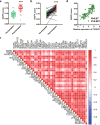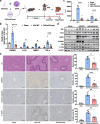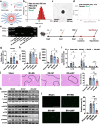Inhibition of cysteine-serine-rich nuclear protein 1 ameliorates ischemia-reperfusion injury during liver transplantation in an MAPK-dependent manner
- PMID: 38902590
- PMCID: PMC11189853
- DOI: 10.1186/s43556-024-00185-z
Inhibition of cysteine-serine-rich nuclear protein 1 ameliorates ischemia-reperfusion injury during liver transplantation in an MAPK-dependent manner
Abstract
Hepatic ischemia-reperfusion injury (HIRI) is a critical pathophysiological process during liver transplantation (LT). Multiple genes and signal pathways are dysregulated during HIRI. This study aims to identify genes as potential therapeutic targets for ameliorating HIRI. Datasets containing samples from the human donor liver (GSE151648) and mouse HIRI model (GSE117066) were analyzed to determine differentially expressed genes (DEGs). The selected DEGs were confirmed by real-time PCR and western blot in the hepatocyte hypoxia-reoxygenation (HR) model, mouse HIRI model, and human liver samples after transplantation. Genetic inhibition was used to further clarify the underlying mechanism of the gene in vitro and in vivo. Among the DEGs, CSRNP1 was significantly upregulated (|log FC|= 2.08, P < 0.001), and was positively correlated with the MAPK signal pathway (R = 0.67, P < 0.001). CSRNP1 inhibition by siRNA significantly suppressed apoptosis in the AML-12 cell line after HR (mean Annexin+ ratio = 60.62% vs 42.47%, P = 0.0019), but the protective effect was eliminated with an additional MAPK activator. Knocking down CSRNP1 gene expression by intravenous injection of AAV-shRNA markedly reduced liver injury in mouse HIRI model (ALT: AAV-NC vs AAV-shCsrnp1 = 26,673.5 ± 2761.2 vs 3839.7 ± 1432.8, P < 0.001; AST: AAV-NC vs AAV-shCsrnp1 = 8640.5 ± 1450.3 vs 1786.8 ± 518.3, P < 0.001). Liver-targeted delivery of siRNA by nanoparticles effectively inhibited intra-hepatic genetic expression of Csrnp1 and alleviated IRI by reducing tissue inflammation and hepatocyte apoptosis. Furthermore, CSRNP1 inhibition was associated with reduced activation of the MAPK pathway both in vitro and in vivo. In conclusion, our results demonstrated that CSRNP1 could be a potential therapeutic target to ameliorate HIRI in an MAPK-dependent manner.
Keywords: Cysteine-serine-rich nuclear protein-1 (CSRNP1); Hepatic ischemia–reperfusion injury (HIRI); Liver transplantation; Mitogen-activated protein kinases; Nanoparticles.
© 2024. The Author(s).
Conflict of interest statement
The authors declare that they have no conflict of interest.
Figures








Similar articles
-
miR-494 up-regulates the PI3K/Akt pathway via targetting PTEN and attenuates hepatic ischemia/reperfusion injury in a rat model.Biosci Rep. 2017 Sep 19;37(5):BSR20170798. doi: 10.1042/BSR20170798. Print 2017 Oct 31. Biosci Rep. 2017. PMID: 28842516 Free PMC article.
-
Remimazolam alleviates hepatic ischemia-reperfusion injury by activating FOXO1/3 signaling : Remimazolam alleviates hepatic ischemia reperfusion injury.BMC Gastroenterol. 2025 Apr 22;25(1):283. doi: 10.1186/s12876-025-03820-3. BMC Gastroenterol. 2025. PMID: 40263992 Free PMC article.
-
The effect of Ginsenoside Rg1 in hepatic ischemia reperfusion (I/R) injury ameliorates ischemia-reperfusion-induced liver injury by inhibiting apoptosis.Biomed Pharmacother. 2020 Sep;129:110398. doi: 10.1016/j.biopha.2020.110398. Epub 2020 Jun 27. Biomed Pharmacother. 2020. PMID: 32603889
-
Targeting NF-κB in Hepatic Ischemia-Reperfusion Alleviation: from Signaling Networks to Therapeutic Targeting.Mol Neurobiol. 2024 Jun;61(6):3409-3426. doi: 10.1007/s12035-023-03787-w. Epub 2023 Nov 22. Mol Neurobiol. 2024. PMID: 37991700 Review.
-
New progress in roles of nitric oxide during hepatic ischemia reperfusion injury.World J Gastroenterol. 2017 Apr 14;23(14):2505-2510. doi: 10.3748/wjg.v23.i14.2505. World J Gastroenterol. 2017. PMID: 28465634 Free PMC article. Review.
References
Publication types
MeSH terms
Grants and funding
LinkOut - more resources
Full Text Sources
Medical
Research Materials
